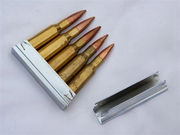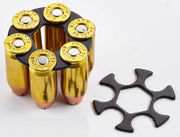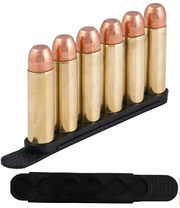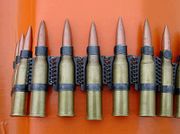Difference between revisions of "Weapon accessories"
m |
|||
| Line 21: | Line 21: | ||
* '''Speed strips''' | * '''Speed strips''' | ||
* '''Ammo belts''' (includes ammo belt boxes, which are designed to contain belts of a specific type and size) | * '''Ammo belts''' (includes ammo belt boxes, which are designed to contain belts of a specific type and size) | ||
| − | * '''Reload packs''' | + | * '''Reload packs''' |
=== Function === | === Function === | ||
| Line 157: | Line 157: | ||
= Muzzle devices = | = Muzzle devices = | ||
| − | ( | + | The term '''muzzle devices''' refers to weapon accessories which are intended to be screwed or attached onto the muzzle of a firearm, usually to alter its performance. |
| + | |||
| + | Four types of items can be found in this category: | ||
| + | * '''Silencers''', also called suppressors | ||
| + | * '''Muzzle brakes''' | ||
| + | * '''Shotgun chokes''' | ||
| + | * '''Bayonets''' | ||
| + | |||
| + | Each type of muzzle device has their own functions and purposes. | ||
| + | |||
| + | == Silencers == | ||
| + | '''Silencers''' (or '''suppressors''', colloquially '''cans''') are sound reduction devices attached to the muzzle of a firearm. As the name implies, their primary function is to decrease the amount of noise generated by gunfire, and their main purpose for doing so is to conceal the shooter, or at least make it more difficult to locate. | ||
| + | |||
| + | Although there is considerable debate on whether 'silencer' or 'suppressor' should be used, the author considers the use of both terms acceptable and interchangeable, and the term 'silencer' will be used as the word to describe the devices throughout the rest of this wiki. | ||
| + | |||
| + | === Effects of silencers === | ||
| + | |||
| + | A firearm with an attached silencer or an integrated silencer is considered to be '''silent''', allowing their user to '''maintain stealth''' when in [[cover]]. This is critical to make ranged attacks without being attacked in turn. | ||
| + | |||
| + | Certain other types of ranged weapons are considered to be '''naturally silent''' by nature, effectively working like a silenced firearm. These weapons include: | ||
| + | |||
| + | * All archery weapons | ||
| + | * [[Nailgun]] | ||
| + | |||
| + | === Weapons compatible with silencers === | ||
| + | In the Mazes, silencers are divided by category (whether they are pistol, rifle, or shotgun silencers), standard (the type of threading or mounting point used to attach the silencer), and bore size. The combination of these descriptors determine which firearms (and which calibers) silencers can be attached to. | ||
| + | |||
| + | Certain silencers are fully integrated to their host firearm, and cannot be removed. They are referred to as '''integrated silencers'''. | ||
| + | |||
| + | As a rule of thumb, revolvers can never be silenced (the gap between a revolver's frame and cylinder renders the use of a silencer useless), with very rare exceptions. | ||
| + | |||
| + | * '''[[List of silencers]]''' | ||
| + | |||
| + | == Muzzle brakes == | ||
| + | '''Muzzle brakes''' (sometimes also known as '''compensators''', or simply '''brakes'''; sometimes, colloquially called '''loudeners''') are recoil mitigation devices attached to the muzzle of a firearm. They work by redirecting some of the gases expelled when firing in another direction than forward, using ports, usually pointed up or to the sides. Because this has the side-effect of also redirecting the muzzle blast and the noise produced by the firearm, muzzle brakes are sometimes given the affectionate moniker of 'loudener', as they appear louder to bystanders than non-braked firearms. | ||
| + | |||
| + | === Effects of muzzle brakes === | ||
| + | |||
| + | A firearm with an attached muzzle brake benefits from a '''[[Recoil]] -1''' modifier. | ||
| + | |||
| + | === Weapons compatible with muzzle brakes === | ||
| + | Muzzle brakes are divided into categories, standards and bore sizes, just like silencers. The combination of these descriptors determine which firearms (and which calibers) muzzle brakes can be attached to. | ||
| + | |||
| + | Certain muzzle brakes are fully integrated to their host firearms, and cannot be removed. They are referred to as '''integrated brakes'''. In addition, certain firearms may have ported barrels which, while not explicitly muzzle brakes or compensators, are considered to work the same way; they are considered to also be integrated brakes. | ||
| + | |||
| + | * '''[[List of muzzle brakes]]''' | ||
| + | |||
| + | == Shotgun chokes == | ||
| + | '''Shotgun chokes''' (or just '''chokes''') are muzzle devices intended to alter the performance of shotguns. In the Mazes, all shotguns are made from the factory with a cylinder bore, and all shotgun chokes are external and intended to be attached to a threaded barrel, for the sake of standardization with other muzzle devices such as silencers and muzzle brakes. | ||
| + | |||
| + | The purpose of a choke is to tighten the pattern of projectiles fired, by forcing them to pass through a tube of a smaller diameter than that of the barrel. The resulting effective constriction forces the projectiles to stay together for a little longer, making the patterns at a given distance tighter than without a choke installed. While this can result in more hits on target (pellets have less dispersion), this also means that choked shotguns must be aimed more accurately. | ||
| + | |||
| + | It must be noted that chokes are only useful with multiple projectile shotgun shells (buckshot, flechette...). When used in conjunction with slugs, at best they have no effect, but may, at worst, have a negative impact on accuracy. | ||
| + | |||
| + | Shotgun chokes are divided by type (how tight the diameter of the choke is at the end, which determines effects), and caliber (determining firearm compatibility). | ||
| + | |||
| + | === Effects of shotgun chokes === | ||
| + | |||
| + | Although the exact effects of a shotgun choke depend on its type and caliber, chokes generally '''modify the dice rolled for projectiles''' when used with multiprojectile shells, generally to offer a higher average amount of pellets hitting the target. Certain chokes may also have '''accuracy modifiers'''. For a detailed list of effects, see the list of shotgun chokes, linked below. | ||
| + | |||
| + | === Weapons compatible with shotgun chokes === | ||
| + | Shotgun chokes can only be attached to firearms chambered for shotgun calibers. Although not technically impossible to implement, there are no weapons with integrated shotgun chokes in the game's weapon roster. | ||
| + | |||
| + | * '''[[List of shotgun chokes]]''' | ||
| + | |||
| + | == Bayonets == | ||
| + | '''Bayonets''' are melee weapons - typically a knife, sometimes a simple metal rod - that are specifically designed to be attached to the muzzle of a firearm. Most bayonets can be used as stand-alone weapons (those that do may count as [[weapons]]), though all of them are primarily intended to be used as weapon accessories. When attached to a firearm, a bayonet allows the host firearm to be used as a more effective melee weapon than simply bashing an enemy with it. | ||
| + | |||
| + | There are many different types of bayonets. The part of a firearm that is designed to accept a bayonet is called a ''bayonet lug''. | ||
| + | |||
| + | === Effects of bayonets === | ||
| + | |||
| + | The purpose of a bayonet is to effectively add an extra mode of usage to the weapon it is attached to; namely, a relatively effective melee option, as well as the ability to perform a [[Charging|bayonet charge]]. | ||
| + | |||
| + | Bayonets capable of being used as stand-alone weapons are referred to as '''knife-bayonets''', count as '''Class 5 Short''' weapons and require the use of '''Knife skills'''. | ||
| + | |||
| + | Firearms with bayonets attached allow for the use of '''Staff/Pole weapon skills'''. | ||
| + | |||
| + | Certain bayonets may be referred to as '''Non-blocking (NB)'''. This means that they are attached to the firearm in a particular way that it does not actually block or obstruct the firearm's muzzle. Non-blocking bayonets '''allow for installing another type of muzzle device''' onto its host weapon, effectively allowing two muzzle devices at once (a bayonet and another type of device). | ||
| + | |||
| + | === Weapons compatible with bayonets === | ||
| + | |||
| + | Each bayonet model has its own compatibility list, which is generally a set list of specific firearms. | ||
| + | |||
| + | * '''[[List of bayonets]]''' | ||
Revision as of 19:28, 9 July 2019
| Navigation: | Main Page → Items → Weapon accessories | |||
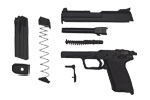
|
This page is actively under construction! Please ask the following users for permission before editing this page: Tempest The list of accessories is incomplete. I'll add more over time. |
Weapon accessories are devices intended to be installed on weapons, typically firearms, in order to improve or modify their functionality or performance. Most weaoon accessories are optional, with perhaps the exception of feeding systems
There are five categories of weapon accessories: Feeding systems, Muzzle devices, Underbarrel devices, Optics, and Lights.
Contents
Feeding systems
The term feeding system is a catch-all for any object whose primary function is to carry ammunition and feed it to a firearm. They are the only type of weapon accessory which could be considered to be essential to the normal function of a firearm; as without these, certain firearms will not be able to fire at all, while others may require manual feeding of ammunition as a reload action in order to be able to fire.
Seven types of items can be found in this category:
- Magazines (including en-bloc clips, which are considered mechanically identical to magazines)
- Moon clips
- Stripper clips
- Speedloaders
- Speed strips
- Ammo belts (includes ammo belt boxes, which are designed to contain belts of a specific type and size)
- Reload packs
Function
All feeding systems can further be differentiated by the way they feed ammunition into weapons during a reload action, using two informal terms: Droppers and Holders.
- Droppers are feeding systems which transfer their ammunition into compatible weapons before being replaced in the inventory or discarded. This suggests that the compatible weapons have internal magazines. The typical example is the speedloader, which is designed to drop the ammunition it carries into a revolver cylinder.
- Feeding systems considered to be droppers: Stripper clips, Speedloaders, Speed strips
- Holders are feeding systems which are meant to be "held" by the compatible weapons in order to feed it. The capacity of such weapons therefore becomes that of the currently held feeding device (excluding the +1 round in the chamber). The reload action is therefore characterized by either the insertion, or the swapping of an old device for a fresh one full of ammunition. The typical example is the box magazine, which is designed to be held by the host firearm (such as a pistol or a rifle).
- Feeding systems considered to be holders: Magazines, Moon clips, Ammo belts, Reload packs
Size tiers
All feeding systems belong to one of size tier, ranging from Tiny to X. Large. The size tier determines the base weight. When feeding systems are loaded with ammunition, their weight changes accordingly.
- Example: An empty STANAG 30-round magazine has a Medium size tier, giving it a base weight of 1 unit. When loaded with 30 rounds of 5.56x45mm NATO (weight per round: 0.01 unit), the weight of that magazine becomes 1.3 units (1 from base weight + 30 x 0.01 from loaded ammunition).
| Feeding system size tiers and base weight | ||||||
| Size tier | Tiny | Small | Medium | Large | V. Large | X. Large |
| Base weight (in weight units) | 0.25 | 0.5 | 1 | 1.2 | 2 | 3 |
Lists of feeding systems
Magazines
Magazines (or mags) are devices designed to hold and feed ammunition into a firearm.
Though they can be internal or integrated to a firearm, the magazines covered as weapon accessories are specifically detachable magazines, intended to be carried as individual items in the inventory, in order to differentiate them with internal magazines, which are an integral part of a weapon and are therefore not treated as items.
Magazines exist in various types, sizes, and capacities, and may have any one of the seven size tiers.
All magazines belong to a magazine type, which can be thought of as a family of magazines, even if that family is made up of just one member.
The general rule of thumb is that all firearms that are compatible with a given magazine type, are compatible with all types of magazines of that type. There are very few exceptions to this rule and those exceptions will be explicitly listed.
- Example: The Colt M16A4 is compatible with STANAG magazines, and can therefore accept any type of STANAG magazine, such as the STANAG 30-round magazine, the STANAG 40-round extended magazine, or even the STANAG 100-round C-MAG drum.
Many magazines may also receive extra descriptors, such as extended magazine, drum magazine, casket magazine, and more. These descriptors do not change their function and only exist to give the player an idea of their shape and purpose. For example, a magazine may be referred to as extended because it has a greater capacity than normal, whereas a drum or casket magazine are called that way to draw attention to their shape.
Stripper clips
Stripper clips are long, thin strips of claw-shaped metal, designed to hold rounds of ammunition in place vertically. They are designed to be inserted in compatible firearms (which must have a clip guide of some sort), so that the ammunition can be pushed down and into the weapon all at once. Stripper clips are designed to drop the ammunition they carry into a compatible firearm, and typically, a type of stripper clip will only be compatible with one, or a few given weapons. Upon completing a reload, the stripper clip has effectively transferred its ammunition to the weapon; though the user can perform a partial reload and end up with a partially loaded clip. This can be done deliberately (by explicitly announcing the amount of rounds one wishes to load in), or out of necessity (if the clip holds more ammunition than the firearm needs to be fully loaded again).
Speedloaders
Speedloaders are round devices, into which the user inserts compatible rounds of ammunition, which is held in place until the knob is turned and all of the ammunition loaded is released all at once. Speedloaders are designed to drop the ammunition they carry into a compatible revolver. Upon completing a reload, the speedloader has effectively transferred its ammunition to the weapon and will become empty. Speedloaders have a capacity and a caliber (sometimes, more than one); they must be used with a revolver of the same capacity, and the ammunition loaded must be compatible with the revolver.
Moon clips
Moon clips are thin strips of metal designed to hold rounds of ammunition and be held in place between a revolver's cylinder and frame; they are designed to hold and feed ammunition into a revolver. Reloading with a moonclip is very similar to reloading with a box magazine; remove old one, insert fresh one. But similarly to speedloaders, moon clips have a capacity and one or more calibers; they must be used with a revolver of the same capacity, and the ammunition loaded must be compatible with the revolver.
Speed strips
Speed strips are primarily (but not always, see below) used for reloading single-action revolvers. Though they do not make the unloading process any faster, they can reduce loading fresh ammunition down to a single turn. Fully unloading then fully reloading a single-action revolver with a speed strip therefore always takes 2 turns.
Speed strips are, as the name implies, long strips made out of rubber, designed to hold rounds of ammunition into a straight line. The rubber strip can be bent and stretched to allow faster insertion than with loose rounds, the idea being to partially insert one round, "rip" it out of the rubber strip, turn the cylinder, and repeat until fully loaded, until the strip is empty, or until the user wishes to stop. They are therefore droppers. Speed strips have a capacity and one or more calibers, but unlike speedloaders and moon clips, capacity doesn't need to match; only the ammunition loaded must be compatible with the revolver. Therefore, it is possible to use a 5-round, 6-round, or even 8-round speed strip with a 6-shot revolver, as long as the caliber is compatible.
| Advanced tip |
| Yes, you can use a speed strip for reloading DA/SA and double-action only revolvers as well; just like the revolver enthusiasts in the real world! If you wish to do so, you must explicitly state as much. Doing so will allow you to load up to 6 rounds per turn (double the amount allowed from reloading with loose rounds). |
Ammo belts
Ammunition belts are, as the name implies, used to feed a belt-fed firearm; typically a machine gun. There are two major kinds of ammo belts: Disintegrating and Non-disintegrating belts. All ammunition belts are designed to hold and feed ammunition into a firearm.
Rounds of ammunition that are loaded in ammo belts may be referred to as belted ammunition or more rarely, linked ammunition.
Non-disintegrating belts
Non-disintegrating belts are the simplest type of ammunition belt available, and can be thought of as essentially large magazines. They function the same way; they have a fixed capacity, and typically are only compatible with one or a few weapons.
They are called "non-disintegrating' because the links holding each round of ammunition are not stripped from the belt and removed as the ammunition is fired. Instead, a machine gun that fires all of the ammunition in a non-disintegrating belt will simply eject the empty belt on the other side, ready to be picked up and reloaded.
Disintegrating belts
Disintegrating belts are a little more involved; they are made up of metallic clamps called belt links. The type of belt link determines which weapons (and in turn, calibers) they are compatible with.
Firearms that can be fed with disintegrating link belts will eject belt links on the floor alongside casings. Unlike casings, there is no Handloading skill requirement to find links; firing 200 rounds will always result in 200 belt links on the floor.
When in possession of compatible belt links and ammunition, you can spend 1 turn to combine 3 links and 3 rounds together. This results in the creation of a loose ammo belt. This act can be scaled to however many rounds you wish to link together.
- Example: If you wish to create a 50-round ammo belt, you will spend 17 turns to combine 50 belt links and 50 rounds.
- Example event line: [Weapon accessory] M13 ammo belt, loose, disintegrating links, 7.62x51mm NATO, 50 rounds - [0 /50] - Weight: (variable, 0.02 per round)
You also have the possibility to spend 1 turn to divide an existing loose belt into two shorter loose belts.
- Example: You can separate a 100-round ammo belt into two 50-round ammo belts, or into one 25-round and one 75-round, etc.
Although links have an individual weight of 0.01, loose ammo belts are not heavier than unlinked ammunition; a 50-round loose belt weighs as much as 50 rounds, for instance. As such, it is always more space efficient to combine ammo and links.
There is no upper limit to how much ammunition can be linked together into loose ammo belts; as long as you can carry it.
Loose belts and belt boxes
It is important to distinguish between loose ammo belts and ammo belt boxes:
Loose ammo belts:
- Have a variable capacity, which depends on however many rounds are linked together.
- Cannot be held by a firearm like a magazine or a belt box - can only be carried in the inventory.
- You may load a loose ammo belt into a compatible firearm, but only if the belt is in a directly accessible part of the inventory. Firearms loaded with such belts are therefore "loaded from the inventory".
Ammo belt boxes:
- Are designed to contain ammo belts of a specific type (e.g. M13 belt boxes can only contain M13 belts, and so on).
- Can be loaded into a compatible firearm, which will hold it, like a magazine. It takes 1 turn to load a loose belt into a belt box.
- Have a listed maximum capacity (e.g. "ammo belt box, 100 rounds").
- You may load a loose belt of any length inside a belt box, as long as it's equal or inferior to the listed capacity. For example, a 74-round loose belt loaded in a 100-round belt box is fine, but a 124-round loose belt is not.
Reload packs
The term reload pack is a generic term for feeding devices that do not fit in the above categories. They are generally groups of objects abstracted as one item in the inventory.
Presently, there are two informal types of reload packs - both work the same way, but have different looks and appearances:
- The nailgun reload pack, a kit containing a roll of nails of a certain length and type, and a CO2 canister with just enough gas to fire all of the nails contained.
- The flamethrower reload pack, which is a kit containing enough fuel to completely refill the compatible weapon's gas tank alongside any other necessities (starter fuel, etc.).
Flamethrowers and nailguns cannot be reloaded until they are empty, reload packs cannot be refilled (as their purpose is to completely refill their relevant weapons to full capacity), and once used as part of a reload action, the reload kits are discarded completely, making them one-use items.
Muzzle devices
The term muzzle devices refers to weapon accessories which are intended to be screwed or attached onto the muzzle of a firearm, usually to alter its performance.
Four types of items can be found in this category:
- Silencers, also called suppressors
- Muzzle brakes
- Shotgun chokes
- Bayonets
Each type of muzzle device has their own functions and purposes.
Silencers
Silencers (or suppressors, colloquially cans) are sound reduction devices attached to the muzzle of a firearm. As the name implies, their primary function is to decrease the amount of noise generated by gunfire, and their main purpose for doing so is to conceal the shooter, or at least make it more difficult to locate.
Although there is considerable debate on whether 'silencer' or 'suppressor' should be used, the author considers the use of both terms acceptable and interchangeable, and the term 'silencer' will be used as the word to describe the devices throughout the rest of this wiki.
Effects of silencers
A firearm with an attached silencer or an integrated silencer is considered to be silent, allowing their user to maintain stealth when in cover. This is critical to make ranged attacks without being attacked in turn.
Certain other types of ranged weapons are considered to be naturally silent by nature, effectively working like a silenced firearm. These weapons include:
- All archery weapons
- Nailgun
Weapons compatible with silencers
In the Mazes, silencers are divided by category (whether they are pistol, rifle, or shotgun silencers), standard (the type of threading or mounting point used to attach the silencer), and bore size. The combination of these descriptors determine which firearms (and which calibers) silencers can be attached to.
Certain silencers are fully integrated to their host firearm, and cannot be removed. They are referred to as integrated silencers.
As a rule of thumb, revolvers can never be silenced (the gap between a revolver's frame and cylinder renders the use of a silencer useless), with very rare exceptions.
Muzzle brakes
Muzzle brakes (sometimes also known as compensators, or simply brakes; sometimes, colloquially called loudeners) are recoil mitigation devices attached to the muzzle of a firearm. They work by redirecting some of the gases expelled when firing in another direction than forward, using ports, usually pointed up or to the sides. Because this has the side-effect of also redirecting the muzzle blast and the noise produced by the firearm, muzzle brakes are sometimes given the affectionate moniker of 'loudener', as they appear louder to bystanders than non-braked firearms.
Effects of muzzle brakes
A firearm with an attached muzzle brake benefits from a Recoil -1 modifier.
Weapons compatible with muzzle brakes
Muzzle brakes are divided into categories, standards and bore sizes, just like silencers. The combination of these descriptors determine which firearms (and which calibers) muzzle brakes can be attached to.
Certain muzzle brakes are fully integrated to their host firearms, and cannot be removed. They are referred to as integrated brakes. In addition, certain firearms may have ported barrels which, while not explicitly muzzle brakes or compensators, are considered to work the same way; they are considered to also be integrated brakes.
Shotgun chokes
Shotgun chokes (or just chokes) are muzzle devices intended to alter the performance of shotguns. In the Mazes, all shotguns are made from the factory with a cylinder bore, and all shotgun chokes are external and intended to be attached to a threaded barrel, for the sake of standardization with other muzzle devices such as silencers and muzzle brakes.
The purpose of a choke is to tighten the pattern of projectiles fired, by forcing them to pass through a tube of a smaller diameter than that of the barrel. The resulting effective constriction forces the projectiles to stay together for a little longer, making the patterns at a given distance tighter than without a choke installed. While this can result in more hits on target (pellets have less dispersion), this also means that choked shotguns must be aimed more accurately.
It must be noted that chokes are only useful with multiple projectile shotgun shells (buckshot, flechette...). When used in conjunction with slugs, at best they have no effect, but may, at worst, have a negative impact on accuracy.
Shotgun chokes are divided by type (how tight the diameter of the choke is at the end, which determines effects), and caliber (determining firearm compatibility).
Effects of shotgun chokes
Although the exact effects of a shotgun choke depend on its type and caliber, chokes generally modify the dice rolled for projectiles when used with multiprojectile shells, generally to offer a higher average amount of pellets hitting the target. Certain chokes may also have accuracy modifiers. For a detailed list of effects, see the list of shotgun chokes, linked below.
Weapons compatible with shotgun chokes
Shotgun chokes can only be attached to firearms chambered for shotgun calibers. Although not technically impossible to implement, there are no weapons with integrated shotgun chokes in the game's weapon roster.
Bayonets
Bayonets are melee weapons - typically a knife, sometimes a simple metal rod - that are specifically designed to be attached to the muzzle of a firearm. Most bayonets can be used as stand-alone weapons (those that do may count as weapons), though all of them are primarily intended to be used as weapon accessories. When attached to a firearm, a bayonet allows the host firearm to be used as a more effective melee weapon than simply bashing an enemy with it.
There are many different types of bayonets. The part of a firearm that is designed to accept a bayonet is called a bayonet lug.
Effects of bayonets
The purpose of a bayonet is to effectively add an extra mode of usage to the weapon it is attached to; namely, a relatively effective melee option, as well as the ability to perform a bayonet charge.
Bayonets capable of being used as stand-alone weapons are referred to as knife-bayonets, count as Class 5 Short weapons and require the use of Knife skills.
Firearms with bayonets attached allow for the use of Staff/Pole weapon skills.
Certain bayonets may be referred to as Non-blocking (NB). This means that they are attached to the firearm in a particular way that it does not actually block or obstruct the firearm's muzzle. Non-blocking bayonets allow for installing another type of muzzle device onto its host weapon, effectively allowing two muzzle devices at once (a bayonet and another type of device).
Weapons compatible with bayonets
Each bayonet model has its own compatibility list, which is generally a set list of specific firearms.
Underbarrel devices
(wip)
Optics
(wip)
Lights
(wip)

